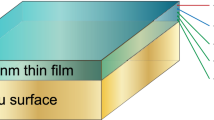Abstract
The adhesion of bacteria to solid surfaces was studied using a physicochemical approach. Adhesion to negatively charged polystyrene was found to be reversible and could be described quantitatively using the DLVO theory for colloidal stability, i.e., in terms of Van der Waals and electrostatic interactions. The influence of the latter was assessed by varying the electrolyte strength. Adhesion increased with increasing electrolyte strength. The adhesion Gibbs energy for a bacterium and a negatively charged polystyrene surface was estimated from adhesion isotherms and was found to be 2–3 kT per cell. This low value corresponds to an adhesion in the secondary minimum of interaction as described by the DLVO theory. The consequences of these findings for adhesion in the natural environment are discussed.
Similar content being viewed by others
References
Absolom DR, Lamberti FV, Policova Z, Zingg W, van Oss CJ, Neumann AW (1983) Surface thermodynamics of bacterial adhesion. Appl Environ Microbiol 46:90–97
Alieva RM, Manasbaeva AB, Ilyaletdinov AN (1987) Immobilization of microorganisms on a latex in order to obtain an artificial floc. Mikrobiol 55:692–699
Baker JH (1984) Factors affecting the bacterial colonization of various surfaces in a river. Can J Microbiol 30:511–515
Beeftink HH, Staugaard P (1986) Structure and dynamics of anaerobic bacterial aggregates in a gas-lift reactor. Appl Environ Microbiol 52:1139–1146
Busscher HJ, Weerkamp AH, van der Mei HL, van Pelt AWJ, de Jong HP, Arends J (1984) Measurement of the surface-free energy of bacterial cell surfaces and its relevance for adhesion. Appl Environ Microbiol 48:980–983
Busscher HJ, Uyen MHMJC, Weerkamp AH, Postma WJ, Arends J (1986) Reversibility of adhesion of oral streptococci to solids. FEMS Microbiol Lett 35:303–306
Costerton JW (1974) Structrure and function of the cell envelope of gram-negative bacteria. Bacteriol Rev 38:87–110
Dazzo FB (1984) Bacterial adhesion to plant root surfaces. In: KC Marshall (ed) Microbial adhesion and aggregation. Springer Verlag, Berlin, pp 85–93
Fletcher M (1977) The effect of culture concentration and age, time and temperature on bacterial attachment to polystyrene. Can J Microbiol 23:1–6
Fletcher M, Loeb GI (1979) Influence of substratum characteristics on the attachment of a marine pseudomonad to solid surfaces. Appl Environ Microbiol 37:1–67
Gafny R, Okon Y, Kapulnik Y, Fisher M (1986) Adsorption ofAzospirillum brasilense to corn roots. Soil Biol Biochem 18:69–75
Gordon AS, Millero FJ (1984) Electrolyte effects on attachment of an estuarine bacterium. Appl Environ Microbiol 47:495–499
Haecht JL van, Bolipombo M, Rouxhet PG (1984) Immobilization ofSaccharomyces cerevisiae by adhesion: Treatment of the cells by Al ions. Biotechnol Bioeng 27:217–224
Hattori R, Hattori T (1985) Adsorptive phenomena involving bacterial cells and an anion exchange resin. J Gen Appl Microbiol 31:147–163
Hoght AH, Dankert J, de Vries JA, Feyen J (1983) Adhesion of coagulase negative staphylococci to biomaterials. J Gen Microbiol 129:2959–2968
Jones MN (1975) Biological interfaces: An introduction to the surface and colloid science of biochemical and biological systems. Elseviers, Amsterdam
Kluepfel DA (1986) Adsorption ofAgrobacterium tumefaciens to susceptible potato tissues: A physisorption process. Appl Environ Microbiol 51:1130–1132
Kruyt HR, Klompé MAM (1942) Solkonzentration und Flockung beim AgJ-sol. Kolloid-Beihefte 54:484–553
Kuhn E, Loosdrecht M van, Giger W, Schwarzenbach RP (1987) Microbial degradation of nitrilitriacetate (NTA) during riverwater/groundwater infiltration: Laboratory column studies. Water Res 21:1237–1248
Larsson K, Glantz PO (1981) Microbial adhesion to surfaces with different surface charges. Acta Odontol Scand 39:79–82
Loder TC, Liss PS (1985) Control by organic coatings of the surface charge of estuarine suspended particles. Limnol Oceanogr 30:418–421
Loosdrecht MCM van, Lyklema J, Norde W, Schraa G, Zehnder AJB (1987) The role of bacterial cell wall hydrophobicity in adhesion. Appl Environ Microbiol 53:1893–1897
Loosdrecht MCM van, Lyklema J, Norde W, Schraa G, Zehnder AJB (1987) Electrokinetic potential and hydrophobicity as a measure to predict the initial steps of bacterial adhesion. Appl Environ Microbiol 53:1898–1901
Marshall KC, Stout R, Mitchell R (1971) Mechanisms in the initial events in the sorption of marine bacteria to surfaces. J Gen Microbiol 68:337–348
Matthyse AG, Holmes KV, Gurlitz RWG (1981) Elaboration of cellulose fibrils byAgrobacterium tumefaciens during attachment to carrot cells. J Bacteriol 145:583–595
Nikovskaya GN, Gordienka AS, Globa LI (1987) Sorption of microorganisms by fibrious materials. Mikrobiol 55:545–548
Nir S (1976) Van der Waals interactions between surfaces of biological interest. Progr Surf Sci 8:1–58
Nordin JS, Tsuchiya HM, Fredrickson AG (1967) Interfacial phenomena governing adhesion ofChlorella to glass surfaces. Biotechnol Bioeng 9:545–558
Pelt AWJ van, Weerkamp AH, Uyen MHWJC, Busscher HJ, de Jong HP, Arends J (1980) Adhesion ofStreptococcus sanguis CH-3 to polymers with different surface-free energies. Appl Environ Microbiol 49:1270–1275
Powell MS, Slater NKH (1982) Removal rates of bacterial cells from glass surfaces by fluid shear. Biotechnol Bioeng 24:2527–2537
Puepke SG, Benny UK (1984) Adsorption of tumorgenicAgrobacterium tumefaciens cells to susceptible potato tuber tissues. Can J Microbiol 30:1030–1037
Rosenberg M, Kjelleberg S (1986) Hydrophobic interactions: Role in bacterial adhesion. Adv Microbial Ecol 9:353–393
Rouxhet PG, Mozes N, Haecht JL van, Reuliause L, Palm-Gennen MH (1984) Immobilization of microbial cells by adhesion to a support. In: Proc 3rd European Congress on Biotechnology. Verlag Chemie, Weinheim, pp I 319–325
Rutter PR, Vincent B (1984) Physicochemical interactions of the substratum, microorganisms, and the fluid phase. In: Marshall KC (ed) Microbial adhesion and aggregation. Springer Verlag, Berlin, pp 21–38
Schlegel HG (1974) Allgemeine Mikrobiologie. Georg Thieme Verlag, Stuttgart
Smit G, Kijne JW, Lugtenberg BJJ (1987) Involvement of both cellulose fibrils and a Ca2+-dependent adhesion in the attachment ofRhizobium leguminosarum to pea root hair tips. J Bacteriol 169:4294–4301
Stotzky G (1985) Mechanisms of adhesion to clays, with reference to soil systems. In: Savage DC, Fletcher M (eds) Bacterial adhesion. Plenum Press, New York, pp 195–253
Turakhia MH, Cooksey KE, Characklis WG (1983) Influence of a calcium-specific chelant on biofilm removal. Appl Environ Microb 46:1236–1238
Volmer M (1925) Thermodynamische Folgerungen aus der Zustandsgleichung für adsorbierte Stoffe. Z Phys Chem 115:253–260
Author information
Authors and Affiliations
Rights and permissions
About this article
Cite this article
van Loosdrecht, M.C.M., Lyklema, J., Norde, W. et al. Bacterial adhesion: A physicochemical approach. Microb Ecol 17, 1–15 (1989). https://doi.org/10.1007/BF02025589
Issue Date:
DOI: https://doi.org/10.1007/BF02025589




